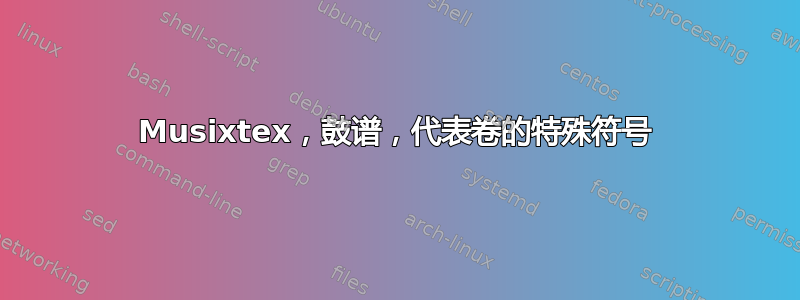
答案1
第一次写音乐代码:看过手册musixdoc.pdf,§18.4.4 页。 92 人被提名颤音。我无法用这个包编写代码。最佳答案来自用户@Alan Munn。
\documentclass[12pt]{article}
\usepackage{musixtex}
\usepackage{wasysym}
\begin{document}
\begin{music}
\setstaffs1{1}
\generalmeter{\meterfrac{3}{4}}
\startextract
\NOtesp\trrml f\zqlp f\trrmu j\qup j\en
\endextract
\end{music}
\end{document}
PS:请参阅@Alan Munn 最佳答案的评论。
答案2
正如 Sebastiano 在他的回答中指出的那样,颤音符号与打击乐符号中用于滚动的符号相同,因此您可以使用各种颤音命令将它们添加到音符中。为了使标记更具语义,我将\let它们设置为\roll,但这实际上只是个人偏好。
您可以使用简写符号将滚动添加到带横线对的第一个音符(第 1 小节的第一个示例),但如果您想将其添加到第二个音符,则需要手动执行该小节(第 1 小节的第二个示例)。向下的谱表将需要手动偏移(第 2 小节),但由于我怀疑您不能用脚滚动,所以这可能不是问题。您的具体示例在第 3 小节中给出。
\documentclass{article}
\usepackage{musixtex}
\input{musixper} % percussion additions (percussion note heads, etc.)
\makeatletter
\let\rollu\trrmu % semantic markup
\let\rolll\trrml %
\begin{document}
\begin{music}
\nobarnumbers
\instrumentnumber{1}
\generalmeter{\meterfrac24}
\setclefsymbol1\drumclef
\startextract
\parindent0pt
\Notes \rollu f\Dqbu ff \en % can be used on the first of a auto barred note pair
\Notes \ibu{1}{f}{0}\qb{1}{f}\rollu f\tqh{1}{f}\en\bar % to get on the second, you need to the bar manually
\Notes \roffset{.5}{\rolll j} \Dqbl jj \qp\en\bar % downward staves will need some offset but probably not needed
\Notes \ibu{2}{f}{0}\islurd{2}{f}\zcn{-5}{R}\zcn{10}{5}\rollu f\qb{2}{f}\tslur{2}{f}\zcn{-5}{R}\zcn{10}{$>$}\tqh{2}{f}%
\ibu{2}{f}{0}\islurd{2}{f}\zcn{-5}{L}\zcn{10}{5}\rollu f\qb{2}{f}\tslur{2}{f}\zcn{-5}{L}\zcn{10}{$>$}\tqh{2}{f}\en
\endextract
\end{music}
\end{document}
答案3
打击乐代码:
\documentclass[a4paper,12pt]{article}
\usepackage[T1]{fontenc}
\usepackage{polyglossia}
\setmainlanguage{spanish}
\usepackage{musixtex}
\input{musixlyr}
\input{musixlyr}
\input {musixcho}
\input {musixdat}%fecha
\input {musixfll}
\input {musixgre}%gregoriano
\input {musixper}%percusión
\input {musixppff}
\input {musixstr}
\input {musixvbm} % experimental vectorized beams
\input {musixdbr} % lineas de barras punteadas, discontinuas y arbitrariamente discontinuas
\input {musixbm} % compatibilidad garrapateas con ganchos o con barras
\input {musixbbm} % compatibilidad semi garrapateas con ganchos o con barras
\usepackage{pifont} % Para usar simbolos ding
\begin{document}
\begin{music}
\largemusicsize
\setlines{1}{0}
\setclefsymbol{1}{\empty}%
\nobarnumbers
\nostartrule
\startextract
{\Huge{\ding{198}}}$\quad$
\NOtes \zcharnote{-10}{\textbf\small \hspace*{0.16cm} R $\quad\,$ R}
\zcn{i}{\hspace*{0.25cm}$5$} \ibu0a0\islurd0a\trrmu a\qb0{a}\tbu0\tslur0a\usf f\qb0{a} \en
\NOtes \zcharnote{-10}{\textbf\small \hspace*{0.16cm} L $\quad\,$ L}
\zcn{i}{\hspace*{0.25cm}$5$} \ibu0a0\islurd0a\trrmu a\qb0{a}\tbu0\tslur0a\usf f\qb0{a} \en
\zendextract
\end{music}
\end{document}






